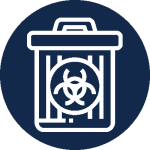Environmental Affairs
The Environmental Affairs office has responsibility for oversight of environmental permitting and compliance activities, such as underground/above ground storage tank management, air quality permits (Title V), water quality (NPDES) permits, surface water quality, storm water management, wetland issues, and environmental assessments at inactive waste sites. This section also manages the hazardous and radioactive waste collection and disposal programs.
Hazardous Materials Email
hazmat_office@office.unc.edu
hazmat_office@office.unc.edu
Related Topics
 Environmental Remediation
Environmental Remediation Hazardous Waste
Hazardous Waste Polychlorinated Biphenyls (PCBs)
Polychlorinated Biphenyls (PCBs) Stormwater
Stormwater Waste Management and Disposal
Waste Management and Disposal
Training
EHS Applications
Spill Prevention Control and Countermeasures Plan
- SPCC Plan (Mar. 2017, Revised Dec. 2022)
- SPCC Plan Design Guidelines
- SPCC Plan Construction Site Guidelines
